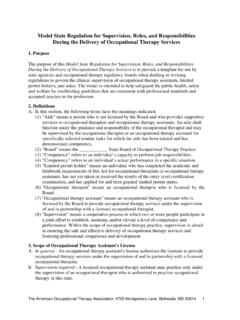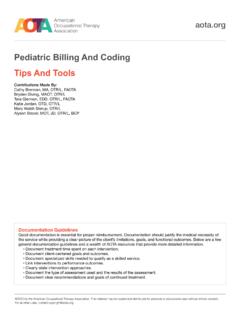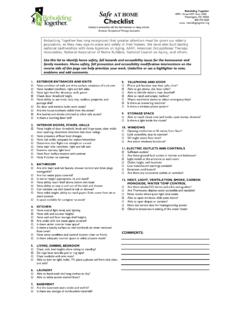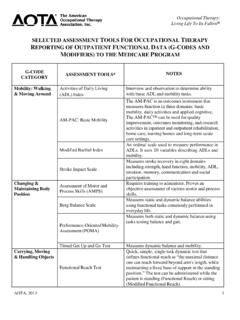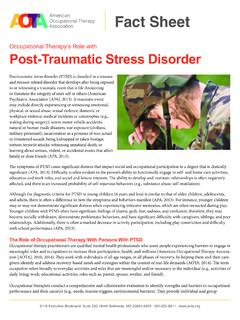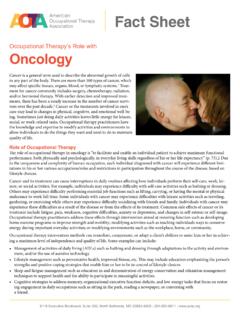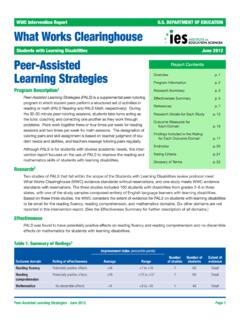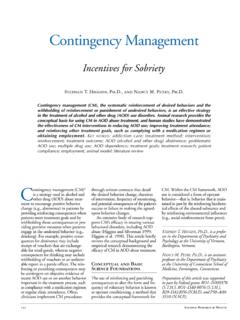Transcription of Fact Sheet - American Occupational Therapy Association
1 Sensory integration involves perceiving, modulating, organiz-ing, and interpreting these sensations to optimize Occupational performance and participation. Well-regulated and appropriately functioning sensory systems contribute to important outcomes in social-emotional, physical and motor, communication, self-care, cognitive, and adaptive skills development and main-tenance. Deficits in sensory integration can pose challenges in performing activities of daily living (ADLs), in addition to de-velopment, learning, playing, working, socializing, and exhibit-ing appropriate behavior (Schaff & Smith Roley, 2006). Sensory integration and modulation disorders often lead people to have extreme over reactions to what others consider mild stimuli, or to completely shut down and disengage. Differenc-es in interpretation of stimuli can impact motor skills and coordination, further limiting engagement and participa-tion. The sensory integration theory and intervention methods researched and developed by A.
2 Jean Ayres, PhD, OTR/L, provide a neuroscience-based approach to addressing sensory integration concerns. Additional approaches emerging from Ayres theory are also used to support sensory intervention, issues in sensory integration continue into adulthood and have been reported to impact work performance, relationships, and general functional abilities (Kinnealey, Koenig, & Smith, 2011). Entry-level therapists are able to address the immediate impact of sensory processing dysfunction on daily activities and behav-ior while therapists with advanced training in sensory integration are able to provide intervention that targets the underlying neurobiological processes involved in sensory processing and integration to affect long-term outcomes. Overview of Occupational Therapy Interventions Collaborate with families, physicians, nurses, speech-language pathologists, physical therapists, psycholo-gists, teachers, employers, and other professionals to determine the need for specialized evaluation and intervention.
3 Identify and modify sensory and environmental barriers that limit performance and participation in every-day activities, as well as individual strengths and supports. Teach and model activities to support sensory, motor, and behavioral needs. Identify and provide adaptive sensory and motor strategies and interventions using a variety of sensory approaches to facilitate full participation in daily routines and social interactions. Help raise an individual s self-awareness of the impact of sensory and motor factors on everyday activities and real life situations, and provide ways to counter sensory processing With Specific Populations Occupational Therapy practitioners address sensory integration and sensory modulation disorders across the life- span and in all environments where clients function through a strengths-based approach to enhance existing skills, while facilitating the carryover of new skills and behaviors into additional situations. Occupational Therapy inter - vention can benefit clients with the following types of issues:Addressing Sensory Integration and Sensory Processing Disorders Across the Lifespan: The Role of Occupational Montgomery Lane, Suite 200, Bethesda, MD 20814-3449 Phone: 301-652-2682 TDD: 800-377-8555 Fax: 301-652-7711 Fact SheetOccupational Therapy enables people of all ages live life to its fullest by helping them to promote health, make lifestyle or environmental changes, and prevent or live better with injury, illness, or disability.
4 By looking at the whole picture a client s psychological, physical, emotional, and social make-up Occupational Therapy assists people to achieve their goals, function at the highest possible level, maintain or rebuild their independence, and participate in the everyday activities of life. Infants and toddlers at risk for developmental problems or who have disabilities. Occupational therapists identify sensory and motor difficulties and provide interventions to facilitate effective self-regulation (wake sleep cycles, alertness level, self-soothing), motor development, and adaptive behavior. These interventions allow children to focus on successful Occupational performance in areas essential for development, such as play, sleep, ADLs, mealtime routines, and socialization (Ayres, 2005; Schaff & Smith Roley, 2006). School aged children with sensory integration problems. A variety of sensory-based approaches can address life skills, participation, and behaviors needed at home, in the community, and in the classroom.
5 In addition to direct intervention, modifications to the home and classroom environments may be recommended to assist children with participating in daily routines, being independent with self-care skills, progressing at school, playing, making friends, and focusing in order to learn (Ayres, 2005, Schaff & Smith Roley, 2006). Adolescents and young adults with a fear of movement, sensitivity to touch, poor motor planning, or de-creased awareness of body position in space. Sensory integration problems may interfere with age-appro-priate life activities such as learning to drive, making vocational choices, engaging in leisure activities, and developing independence and romantic relationships. Practitioners may provide direct Occupational Therapy interventions to address sensory integration and modulation issues and/or may provide accommodations and education to facilitate and improve an adolescent s functioning. As these young people transition into lifelong work and leisure experiences, Occupational Therapy practitioners can play an important role in iden-tifying and supporting successful performance in these areas (Kinnealey et al.)
6 , 2011). Adults of all ages with sensory processing disorders. Many adults have never been diagnosed, so they haven t had the opportunity to develop coping skills and adaptive performance mechanisms. Many of these adults have trouble with interpersonal relationships, vocational skills, leisure activities, and general quality of life. Occupational Therapy practitioners can provide direct services, or they can offer accommodations and sup-ports. For example, an adult who is easily distracted at work may benefit from an Occupational therapist who works with the client and employer to recommend modifications such as headphones if feasible, or envi-ronmental adaptations such as moving the client s desk to minimize external sensory input. Adults without healthy leisure activities could also benefit from an Occupational therapist who can analyze their sensory needs, identify their strengths, then offer options and supports that promote engagement (Kinnealy et al., 2011).
7 ConclusionOccupational Therapy services for sensory integration and processing problems are available in schools, occu-pational Therapy clinics and facilities, and through referral from a physician. After an initial evaluation, occu-pational therapists work closely with the individual and family members to create a focused intervention plan to promote Occupational performance and help individuals maximize participation in daily living , A. J. (2005/1976). Sensory integration and the child. Los Angeles: Western Psychological , M., Koenig, K. P., & Smith, S. (2011). Relationships between sensory modulation and social supports and health related quality of life. American Journal of Occupational Therapy , 65, 320 327. doi: , R. C., & Smith Roley, S. (2006). Sensory integration: Applying clinical reasoning to practice with diverse population. Austin, TX: by Annie Baltazar Mori, OTD, OTR/L, for the American Occupational Therapy Association . Copyright 2015 by the American Occupational Therapy Association .
8 This material may be copied and distributed for personal or educational uses without written consent. For all other uses, contact
